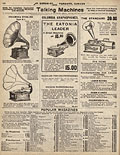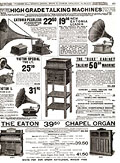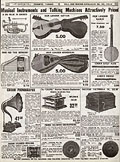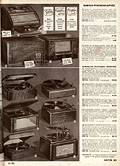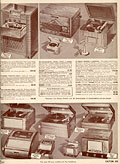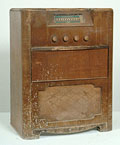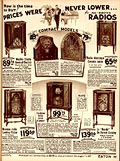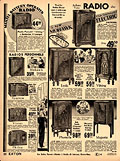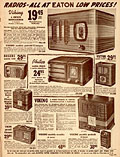|
|
| |
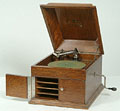 |
|
| |
 Mechanical
gramophone, table model VV-VIII, Victor Talking Machine, Camden, New
Jersey, 1913. Mechanical
gramophone, table model VV-VIII, Victor Talking Machine, Camden, New
Jersey, 1913.
|
|
| |
|
|
|
Objects that Speak:
A Technological Revolution
by Nicole
Cloutier
Until the end of the 19th century, families gathered in
the
evening and celebrated with musicians. Two major revolutions in sound
technology
—the introduction of the sound reproducer at the beginning of the
20th
century and the invention of the radio in the 1920s — changed the
daily
lives of Canadians.
The Phonograph and the Gramophone |
The
Radio
|
The Phonograph and the Gramophone
Edison's Invention: The Cylinder
The cylinder phonograph was invented by American Thomas Edison
(1847-1931)
and appeared in affluent Canadian homes after 1891, when Edison's
company
was marketing a series of music recordings on cylinders.
Berliner's Invention: The Flat Disk
After creating the gramophone, Emile Berliner (1851-1929), an
American
of German origin, invented the flat disk, which played at 78 revolutions
per
minute (rpm). In 1900, he set up a factory in Montréal. The success
of
his invention was immediate, and Berliner Gramophone published a catalogue
of
records that could be ordered by mail.
Major Players in the Sound Industry
| |
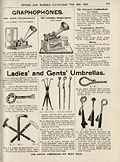 |
|
| |
 Eagle
Graphophone. Eaton's, Toronto, Spring/Summer Catalogue, 1899,
p. 191. Eagle
Graphophone. Eaton's, Toronto, Spring/Summer Catalogue, 1899,
p. 191.
|
|
| |
|
|
|
The three major players in the sound industry, Berliner Gramophone,
Edison,
and Columbia, captured the market. Department store mail-order services
made
the new entertainment machines available throughout Canada. In 1899, the
Eaton's
catalogue offered apparatus for cylinders for the first time: the Columbia
Graphophone
and the Eagle Graphophone, similar to Columbia's model B.
| |
 |
|
| |
 Columbia
Graphophone, Model B. The BX model, which was very similar to this one,
appeared in Eaton's (Toronto) Spring/Summer Catalogue, 1900,
p. 174. Columbia
Graphophone, Model B. The BX model, which was very similar to this one,
appeared in Eaton's (Toronto) Spring/Summer Catalogue, 1900,
p. 174.
|
|
| |
|
|
|
Columbia's Graphophone for flat disks first appeared in the
Eaton's
Catalogue in 1903, competing with Edison's phonograph. The
1904-05
edition of the catalogue offered seven-inch brown records and Berliner
Gramophone's
Model A gramophone. In 1903, Eaton's published a record catalogue in
an
effort to take advantage of the rapid market growth. In Berliner
Gramophone's
first two years in Montréal, the company produced 2000 records. By
1912,
the company was manufacturing two million annually.
|
| |
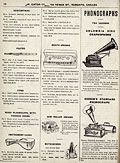 |
|
| |
 Columbia
Graphophone and Edison phonograph, standard model. Eaton's, Toronto
Spring/Summer
Catalogue, 1903, p. 198. Columbia
Graphophone and Edison phonograph, standard model. Eaton's, Toronto
Spring/Summer
Catalogue, 1903, p. 198.
|
|
| |
|
|
|
|
| |
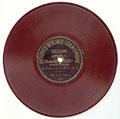 |
|
| |
 Seven-inch
record, Berliner Gramophone, Montréal, ca 1902. Seven-inch
record, Berliner Gramophone, Montréal, ca 1902.
|
|
| |
|
|
|
|
| |
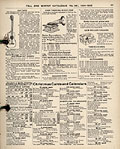 |
|
| |
 Berliner
Gramophone, Model A. Eaton's, Toronto, Fall/Winter Catalogue, 1904-05,
p. 207. Berliner
Gramophone, Model A. Eaton's, Toronto, Fall/Winter Catalogue, 1904-05,
p. 207.
|
|
| |
|
|
|
|
From 1907 to 1910, Eaton's introduced a record player called the
Eatonia.
The Berliner gramophones vanished from its catalogue. However, the company
did
continue to offer the Columbia brand as well as Edison phonographs. Models
of
the Victor Talking Machine, which were distributed in Canada by Berliner
Gramophone,
did not appear in the catalogue until 1910. For the first time,
Eaton's
offered a floor model with an integrated speaker, rather than a horn.
The Flat Disk Replaces the Cylinder
The brand new Victrola XI was the star of the 1913 Eaton's
Catalogue
and was sold at the same price as in the 1912 Berliner Gramophone
catalogue.
In 1913-14, Eaton's offered the popular Victrola VIII and IX.
Since
consumers preferred records to the cumbersome cylinders because they were
easier
to store and less fragile, the company stopped selling cylinder
phonographs in
1914.
| |
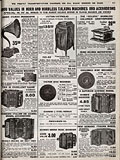 |
|
| |
 Victor
Victrola XI. Eaton's, Toronto, Spring/Summer Catalogue, 1913,
p. 167. Victor
Victrola XI. Eaton's, Toronto, Spring/Summer Catalogue, 1913,
p. 167.
|
|
| |
|
|
|
|
| |
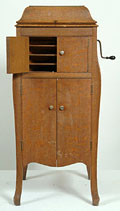 |
|
| |
 Victrola
VV-X mechanical gramophone, floor model, Victor Talking Machine, Camden,
New Jersey, ca 1907. Victor Talking Machine products were distributed
in Canada by Berliner Gramophone of Montréal. The floor model seen
here
is very similar to the XI, which could be ordered from the Eaton's
catalogue. Victrola
VV-X mechanical gramophone, floor model, Victor Talking Machine, Camden,
New Jersey, ca 1907. Victor Talking Machine products were distributed
in Canada by Berliner Gramophone of Montréal. The floor model seen
here
is very similar to the XI, which could be ordered from the Eaton's
catalogue.
|
|
| |
|
|
|
|
In 1917-18, Eaton's offered His Master's Voice
gramophones,
and, starting in 1918, devoted a whole page in the catalogue to Victor and
Columbia
records. In 1919-20, the company sold floor models of gramophones
under
the brand name of Symphony, which was changed to Eatonola the following
year.
Portable record players in suitcases were introduced in 1924 and sold for
several
years.
| |
 |
|
| |
 Five
instruments from His Master's Voice. Eaton's, Toronto, Fall/Winter
Catalogue,
1917-18, p. 321. Five
instruments from His Master's Voice. Eaton's, Toronto, Fall/Winter
Catalogue,
1917-18, p. 321.
|
|
| |
|
|
|
|
| |
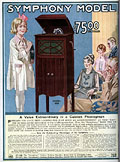 |
|
| |
 Eaton's
Symphony Phonograph. Eaton's, Toronto, Fall/Winter Catalogue, 1919-20,
p. 588. Eaton's
Symphony Phonograph. Eaton's, Toronto, Fall/Winter Catalogue, 1919-20,
p. 588.
|
|
| |
|
|
|
|
| |
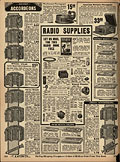 |
|
| |
 Portable
phonograph. Eaton's, Toronto, Fall/Winter Catalogue, 1924-25,
p. 316. Portable
phonograph. Eaton's, Toronto, Fall/Winter Catalogue, 1924-25,
p. 316.
|
|
| |
|
|
|
|
|
| |
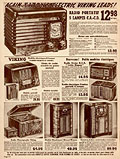 |
|
| |
 Viking combined radio and record players. Eaton's,
Toronto, Fall/Winter Catalogue, 1939-40, p. 374. Viking combined radio and record players. Eaton's,
Toronto, Fall/Winter Catalogue, 1939-40, p. 374.
|
|
| |
|
|
|
Until the end of the 1930s, the Eaton's Catalogue featured only
mechanical
gramophones. The Victor Orthophonic, marketed as a revolution in sound
technology,
was introduced in 1925 by Victor Talking Machine. By 1929-30,
Eaton's
was selling the new Model 43 Victor Orthophonic. In its 1939-40
catalogue,
Eaton's offered the first electric model record player, under its
own brand
name, Viking; this model included a radio. Table models of Viking record
players
were released in 1946. The following year, Eaton's offered the
Astra, a
model that featured a radio and a record player and was very modern in
design.
In the early 1950s, the company still sold a battery-operated combined
model
for homes without electricity.
|
|
|
"Battle of the Speeds"
The late 1940s saw the emergence of the "speed war." In
1948,
Columbia introduced the long-playing record (33 rpm on vinyl) to replace
the
78 rpm. RCA Victor responded the following year by launching the 45
rpm.
In 1952-53, Eaton's offered the popular RCA Victor record
player,
which was made of plastic and appeared on the market at the same time as
the
45 rpm. This model could be connected to a radio or television speaker. At
the
time, record players had three speeds - 33, 45 and 78 rpm -
and Eaton's
introduced its first Viking model with that feature.
| |
 |
|
Plastic record player for
45 rpm records, Model 9JY, RCA Victor, ca 1950. Eaton's sold this record
player for $19; it was very popular among teenagers in the 1950s.
|
 |
|
|
|
The Radio
Crystal Radios
| |
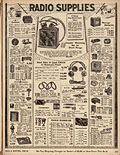 |
|
| |
 Crystal
radio receiver and accessories. Eaton's, Toronto, Fall/Winter Catalogue,
1922-23, p. 401. Crystal
radio receiver and accessories. Eaton's, Toronto, Fall/Winter Catalogue,
1922-23, p. 401.
|
|
| |
|
|
|
Another invention revolutionized the way people listened to music at
home.
Many amateurs built their own crystal radios to pick up radio waves. The
first
programs were broadcast from Montréal starting on December 1, 1919,
by
the Marconi company's experimental station, XWA, which became CFCF
in November
1920. Regular programming began on May 21, 1920. CKAC launched its regular
French
programming on September 27, 1922.
Given the radio craze in Canada, Eaton's featured crystal radios
with
headphones in its 1922-23 catalogue and devoted a whole page to all
the
parts needed to build such a radio. In 1924, Eaton's announced the
publication
of a special parts catalogue.
|
Speakers
A battery-operated receiver with a speaker allowed several people to
listen
to the radio at the same time. In 1925-26, Eaton's sold a
model with
five vacuum tubes and a speaker. Radios were so popular that they even
made it
onto the cover of the company's catalogue. In the winter of
1926-27,
the Minerva, a model produced especially for Eaton's, sold for $99 .
The
cover of the Eaton's 1927-28 Radio Catalogue featured a floor
model
with an incorporated speaker.
| |
 |
|
| |
 Radio
receiver and speaker. Eaton's, Toronto, Fall/Winter Catalogue, 1925-26,
p. 391. Radio
receiver and speaker. Eaton's, Toronto, Fall/Winter Catalogue, 1925-26,
p. 391.
|
|
| |
|
|
|
|
| |
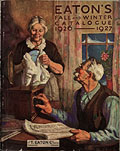 |
|
| |
 Eaton's,
Toronto, Fall/Winter Catalogue, 1926-27, cover. Eaton's,
Toronto, Fall/Winter Catalogue, 1926-27, cover.
|
|
| |
|
|
|
|
| |
 |
|
| |
 Minerva
radio. Eaton's, Toronto, Fall/Winter Catalogue, 1926-27, p. 306. Minerva
radio. Eaton's, Toronto, Fall/Winter Catalogue, 1926-27, p. 306.
|
|
| |
|
|
|
|
| |
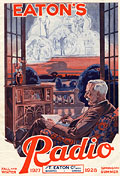 |
|
| |
 Minerva
radio. Eaton's, Winnipeg, Radio Spring/Summer Catalogue, 1927-28,
cover. Minerva
radio. Eaton's, Winnipeg, Radio Spring/Summer Catalogue, 1927-28,
cover.
|
|
| |
|
|
|
|
Combination Radio and Record Players
Very early on, manufacturers began to offer models combining a radio
and record
player, which Sonora marketed around 1924. However, these units did not
appear
in the Eaton's Catalogue until the late 1930s. They became essential
pieces
of furniture in almost every home and occupied a place of honour in the
living
room.
In the early 1930s, Eaton's sold floor models of radios that ran
on
batteries or AC power and were manufactured by Marconi, Eveready, Fada,
Brunswick,
Westinghouse, Zenith, Philco, Sonora, De Forest, Crosley, and Victor.
|
Small Units
The size and retail price of radios began to decrease. In 1934,
Eaton's
offered small table models with wooden cases made by Victor, Philco, and
Sparton,
as well as its own Viking model. A portable Viking radio and the popular
Little
Nipper, made by RCA Victor, first appeared in the 1939-40
catalogue.
After the Second World War, manufacturers produced small units with
wooden
or Bakelite® cases in bright colours, such as Northern
Electric's B
4000 and Westinghouse's 501, a unique Canadian design that stood in
various
positions.
| |
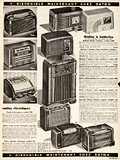 |
|
| |
 Northern
Electric radio receiver, model 4000. Eaton's, Toronto, Spring/Summer
Catalogue, 1946, p. 367. Northern
Electric radio receiver, model 4000. Eaton's, Toronto, Spring/Summer
Catalogue, 1946, p. 367.
|
|
| |
|
|
|
|
| |
 |
|
| |
 Radio,
Model M45A, RCA Victor, 1946. Radio,
Model M45A, RCA Victor, 1946.
|
|
| |
|
|
|
|
| |
 |
|
| |
 Bakelite® radio,
Model B 4000,Northern Electric, Canada, ca 1946. Similar to the B 5000,
this model appeared in Eaton's Spring/Summer Catalogue, 1946, p. 367.
This design was nicknamed Rainbow. Bakelite® radio,
Model B 4000,Northern Electric, Canada, ca 1946. Similar to the B 5000,
this model appeared in Eaton's Spring/Summer Catalogue, 1946, p. 367.
This design was nicknamed Rainbow.
|
|
| |
|
|
|
|
| |
| |
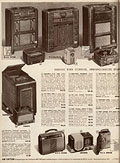 |
|
| |
 Assorted
radios. Eaton's, Toronto, Fall/Winter Catalogue, 1948-49, p. 468. Assorted
radios. Eaton's, Toronto, Fall/Winter Catalogue, 1948-49, p. 468.
|
|
| |
|
|
|
|
| |
 |
|
| |
 Plastic
radio, Model 501, Westinghouse, Canada, 1948. Plastic
radio, Model 501, Westinghouse, Canada, 1948.
|
|
| |
|
|
|
|
| |
 |
|
| |
 Metal
and plastic portable battery-operated superheterodyne radio, Model BP6C,
RCA Victor, Montréal. Metal
and plastic portable battery-operated superheterodyne radio, Model BP6C,
RCA Victor, Montréal.
|
|
| |
|
|
|
|
RCA Victor's BP6C, a portable battery-operated radio, gave
consumers
a taste of the new 1950s design. The 1952 Eaton's Catalogue featured
the
Nipper, a popular RCA Victor model. In 1955-56, the company offered
the
Crosley, the first combination radio and alarm clock, which was equipped
with
an electrical outlet for a coffeemaker. RCA Victor's portable P-233,
which
ran on batteries or AC power, also became affordable.
| |
 |
|
| |
 Assortment
of radios. Eaton's, Toronto, Spring/Summer Catalogue, 1952,
p. 309. Assortment
of radios. Eaton's, Toronto, Spring/Summer Catalogue, 1952,
p. 309.
|
|
| |
|
|
|
|
| |
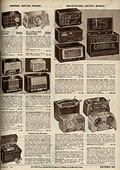 |
|
| |
 Crosley
clock radio. Eaton's, Toronto, Fall/Winter Catalogue, 1955-56,
p. 439. Crosley
clock radio. Eaton's, Toronto, Fall/Winter Catalogue, 1955-56,
p. 439.
|
|
| |
|
|
|
|
|
| |
 |
|
| |
 Bakelite® clock
radio, Model D-25, Crosley, Toronto, ca 1954. This model was available
in various colours. Bakelite® clock
radio, Model D-25, Crosley, Toronto, ca 1954. This model was available
in various colours.
|
|
| |
|
|
|
|
| |
 |
|
| |
 Plastic
radio, Nipper model, RCA Victor, Montréal, ca 1952. Plastic
radio, Nipper model, RCA Victor, Montréal, ca 1952.
|
|
| |
|
|
|
|
| |
 |
|
| |
 Plastic
portable radio, Model P-233, RCA Victor, Montréal, 1956. Plastic
portable radio, Model P-233, RCA Victor, Montréal, 1956.
|
|
| |
|
|
|
|
Radios for Every Budget
In the mid-1950s, Eaton's offered a wide variety of models for
every
budget, ranging from General Electric's modest 418 at a cost $23.95
to
the sophisticated SX-96 made by Hallicrafters, which sold for $449.
| |
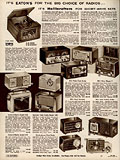 |
|
Assortment of radios offered
in Eaton's (Toronto) Fall/Winter Catalogue, 1956-57, p. 414.
|
 |
|
|
|
|
|








